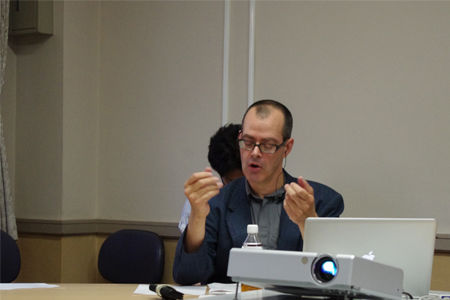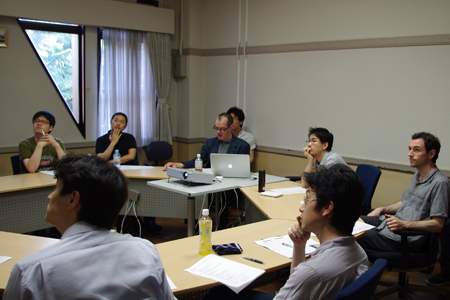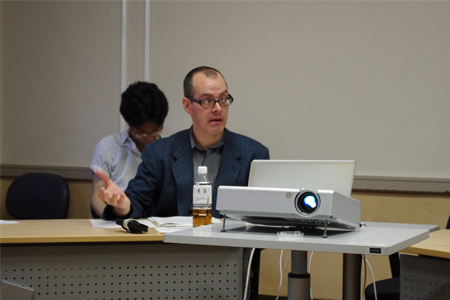[Report] Modernism and Humor: Reflections on the Critical Cinema of the Shōwa 30s
On June 22, M. Downing Roberts gave a presentation entitled "Modernism and Humor: Reflections on the Critical Cinema of the Shōwa 30s". Dr. Roberts is a research fellow at UTCP, and this presentation draws from his ongoing study of postwar cinema.

The socially-critical cinema of postwar Japan is often assumed to take shape around 1960 in the movement known as the Shōchiku New Wave. Further, it is frequently claimed that the critical power of these films stems from their disruptive, modernist aesthetic. These ideas were shaped over a period of several decades, and explored by using the theory of political modernism to interpret postwar Japanese film. On this interpretation, exemplary works would include Oshima Nagisa’s Night and Fog in Japan (Nippon no yoru to kiri, 1960), and Yoshida Kijū’s Eros + Massacre (Erosu purasu gyakusatsu, 1969). Roberts draws attention to the fact that there were many studio films produced during this period which could be considered socially-critical works, but which nevertheless do not seem to fit into the paradigm of political modernism. He asks: how, then, should we think about the socially-critical cinema of this period?
As a way to approach this question, Roberts offers brief accounts of the concepts of "critical cinema" and "modernist film" in the context of postwar Japanese cinema. The former involves the use of narrative strategies that encourage the audience to reflect on broader social contradictions or power relations. With respect to what has been called modernist film, Roberts explores the particularities of the concept of kindaishugi, and the ways in which it is distinct from what has been called "modernism" in European and American writings on film. That is, what does kindaishugi mean in the context of Japanese film, and how might we compare this with the notion of political modernism?

To elaborate these ideas, three films concerning the student movement and the ANPO-tōsō are illustrative: Shinoda Masahiro’s The Dry Lake (Kawaita mizûmi), Oshima’s Night and Fog in Japan (Nippon no yoru to kiri), and Masumura Yasuzō’s The False Student (Nise Daigakusei). All three were released in the summer and fall of 1960, with each offering a distinct interpretation of the student movement. Of particular interest are the narrative strategies used by these films, and their analyses of the failures of the student movement. By refusing clear-cut judgments, each of these three films invites us to reflect on questions of praxis and self-deception. Their stories invite us to seek meaning in the movement's failures, to overcome disillusionment through a sharpened sense of the problems of resistance, violence, and compromise.
Comparing the narrative strategies in these films, Roberts proposes that we can gain insight into their critical function by looking at their use of theatricality (in the case of Oshima's film), irony, and satire (in the case of Shinoda's and Masumura's films). To understand the dimensions of film satire, it is helpful to contrast it with different types of comedy. In Japanese film criticism, some of the principle styles of film comedy have been: slapstick, nonsense comedy, parody, comedy of affinity, comedy of manners, and satire. Historically, slapstick is the earliest form, while social satire becomes more common during the postwar period. In particular, the mechanisms of satire can be grasped more clearly when this mode is contrasted with comedy of affinity. Roberts argues that while both theatricality and satire work to open a distance between the audience and the drama, satire functions within the narrative or diegetic logic of the film, to create a more homogeneous space for critical reflection.

The presentation was followed by a discussion of a number of interesting questions, e.g.: how should we understand the space of reflection that is opened by the devices of satire? Is there a sense in which the distinction between theatricality and satire needs to be pressed further, to account for a broader range of distancing effects? What can be said about the representation of gender in these three films on the ANPO-tōsō? How is it that generic distinctions seem more suited for talking about comedy, rather than satire, which appears more as a mode or a rhetoric?
(UTCP)






